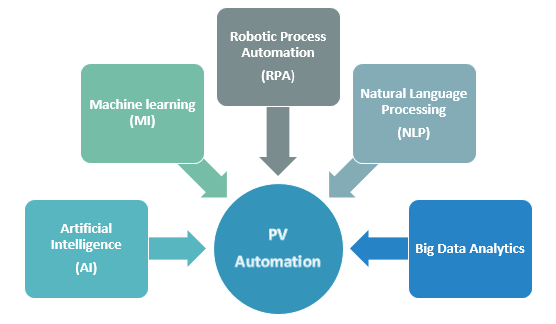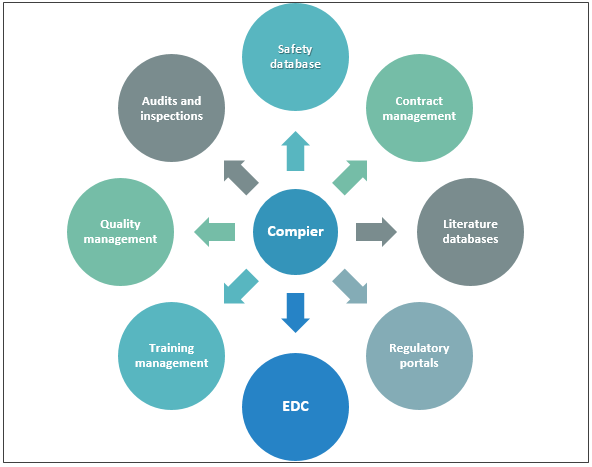- June 25, 2021
- Posted by: Techsol Life Sciences
- Category: Pharmacovigilance

PV Industry Outlook
Pharmacovigilance (PV) is the function in the drug development process that ensures patient safety and release of high-quality medicinal products to the market. Life sciences organisations receive huge volumes of adverse event information from patients, manufacturers, and healthcare professionals to analyse, assess and report it to the authorities in a timely manner. This process of capturing repetitive adverse event data becomes challenging on a day-to-day basis, as it is not only time-consuming but also extremely costly for the organization.
Pharmaceutical companies can leverage latest automation technologies such as artificial intelligence (AI) and machine learning (ML), natural language processing (NLP), and deep learning to eliminate manual PV processes and facilitate faster decision-making.
Automation empowers organizations to recognize greater efficiency, quality of work and the speed at which manual tasks can be accomplished while re-directing valuable resources to focus on higher-order tasks. It also helps in addressing the global requirements of detection, assessment and understanding of drug-related problems including signal detection, risk management, adverse event reporting, and other activities.
Contact us by submitting a business inquiry online. We will get back to you very soon.
Automation – A Game Changer in PV
With the use of automation Pharmaceutical can realize significant value-add across all the core areas of PV such as literature screening, ICSR reporting, and signal detection in drug safety, pharmacovigilance analytics, and benefit-risk assessment. Repetitive and routine manual tasks such as adverse event case intake, Individual Case Study Report (ICSR) processing, and data quality assurance can be automated and tackled by AI in a refined and seamless way.
The use of advanced technology in PV adds value across the whole spectrum of pharmacovigilance operations starting from AE data management in clinical development; preparation of programmed summary tabulations; and listings for aggregate reporting, social media monitoring, and post-marketing surveillance.
PV automation holds the potential to improve compliance, higher reporting volumes, and speed, which in turn helps companies with quality evidence available for scientific assessment and to expedite decisions about the minimization of risks associated with medicines.
Key Drivers for PV Automation
- The volume of adverse event (AE) cases is growing rapidly with increasing disease complexity
- Global regulations becoming more complex due to increased regulatory scrutiny
- Rising organizational pressure to minimize costs
- Regulators evaluating real-world evidence (RWE) sources
- Data science and automation evolving for signal detection and case management
- Increased focus on risk/benefit analysis and signal management
- Need for advanced safety data analytics tools
- The Consumer is demanding improved focus on patient centricity
- Medicinal product portfolios are increasing in complexity
Shaping the Path Forward with Various Automation Platforms in PV
PV automation tools range from basic to robotic process automation, offering a wide variety of technology solutions that can be employed to drive operational efficiencies across the PV continuum.
- Artificial Intelligence (AI)
- Machine Learning (ML)
- Robotic Process Automation (RPA)
- Natural Language Processing (NLP)
- Big Data Analytics

These novel automation technologies offer significant opportunities to boost the process of PV with the following benefits:
- Reduce the need for outsourcing to multiple service providers
- Facilitate cross-functional process integration
- Eliminate manual errors that result in poor quality
- Increase process efficiency and resource productivity
Role of Automation in Reducing Literature Screening Time
Literature screening is conducted to identify abstracts and articles that provide information on serious and non-serious ICSR reports and risk-benefit assessment of a medicinal product under evaluation.
As part of PV workflow, literature screening is more than just a drug safety regulatory obligation. The insights into safety issues like drug interactions to identify patient safety risks and allow the preparation of critical reports that may have to be sent to regulatory bodies.
This is incredibly time-consuming and labor-intensive work, with the risk of inefficiencies like the same document being viewed multiple times. It requires timely processing of records as it puts market authorization holders (MAH) at risk of non-compliance and regulatory fines.
Automation in literature screening helps identify both new and significant ICSRs of Adverse Reactions and relevant medicinal products’ periodic safety update reports (PSUR).
The use of NLP helps understand the relationship in sentences during literature screening and quickly identifies ADEs from a wide area of sources such as Embase and PubMed.
Automation in literature screening aids in reviewing the medical literature and monitoring the article channel from a single browser interface. It drastically reduces review time by automatically eliminating repeated redundant information.
Decreasing ICSR Case Processing Time using Automation
In PV, ICSR processing is resource-intensive, attributing to the approval of new therapies, evolving regulations, patient support programs and an increase in sources of adverse event reporting through social media and mobile applications. But, it also carries the risk of operational inefficiencies and errors.
There is a tremendous burden of manually processing these adverse event report cases. The advent of robotic process automation (RPA), cognitive computing and ML present a significant opportunity to automate several steps in the ICSR process and thereby reducing the case intake time.
Companies receive cases from different sources such as clinical trials, spontaneous reports and literature in both structured and unstructured formats depending on the source of data being collected. This data is further acknowledged for receipt and checked for duplications. The cases are then reviewed to prioritize based on key factors such as life-threatening, resulting in death, disabling etc. and then the case is assigned to a particular person or workflow for further processing.
Automation with AI can be brought in steps during case intake, acknowledgment of receipt of data, duplicate checks, submissions, distribution and prioritization/triage. ML and NLP can be used for screening digital media, and extracting and classifying data from various source documents. This automation would not only result in reducing the time and costs but also helps eliminate errors and improve overall consistency during information processing.
Most significantly, intelligent automation of the ICSR process will benefit patients by enhancing safety signal detection and risk management.
Enhancing Signal Management Processing through Automation
The signal management process is defined as the set of activities performed to determine whether there are any new risks associated with a medicinal product up on examining ICSRs, aggregated data from active surveillance systems, and literature information.
Signal management processing includes signal detection, analysis and prioritization, evaluation/validation, and signal assessment to recommend a future course of action. It primarily addresses the risk-management strategy.
The signal management system must be compliant, rapid, and efficient. By using an automated system, advanced algorithms will be able to complete most of the cumbersome steps, pertaining to signal detection and evaluation/validation, and other important activities at the adverse event level. As a result, these advanced automation technologies will significantly reduce time, resources and expenses for signal management.
How Techsol’s PV Compier Platform can Enhance and help Companies Transform their PV Processes
Compier is our compliance-driven platform addressing various challenges associated with pharmacovigilance. We at Techsol, help organizations in bringing in automation and regulatory compliance. The platform is engineered with modern technology to facilitate automation-driven process workflows and it enables companies to make informed decisions using actionable insights.
Compier Platform PV Modules we offer
At Techsol, we understand the benefits that these automation tools offer and how our clients can take advantage of them. With highly configurable modules, sponsors and service providers can opt for one or more application modules in varying combinations according to their business need. Every module focuses on addressing a quality or improvising compliance.
Key Platform components
Following are some of the key platform components which enable operational oversight and compliance management across various PV Operations:
- Process Alerts & Notifications
- Integrated Email Inbox
- PVOps Business Intelligence Studio
- Process Automation
- Audit Trail & Utilities
- Cross-Functional System Integrations
- Business Workflows
- Digitalization of content
- Collaboration on tasks and activities

* Compier Interfaces and Integrations



